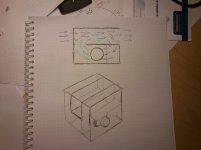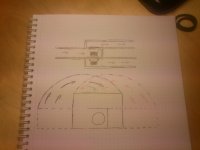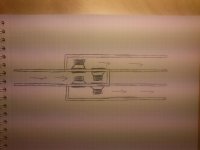Hello there all!
I've been wondering some about this: Open baffled subwoofers are more efficient the larger the baffle is, so why are most baffles on the subwoofer drawings on the net so small?
Shouldn't it be possible to approximate a much larger baffle and getting more bass by folding it like in my drawing?
If you already use DSP to handle delaying the other speakers and EQing the response is there some big disadvantage of doing this?
My other idea was stacking with 4 drivers to make my subwoofer, but the shouldn't the folded one in theory have the same output but with two instead of four drivers, thus at halved cost.
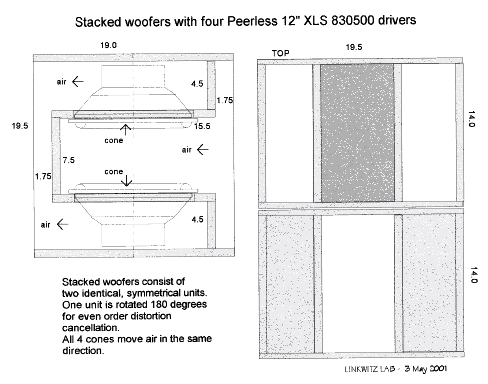
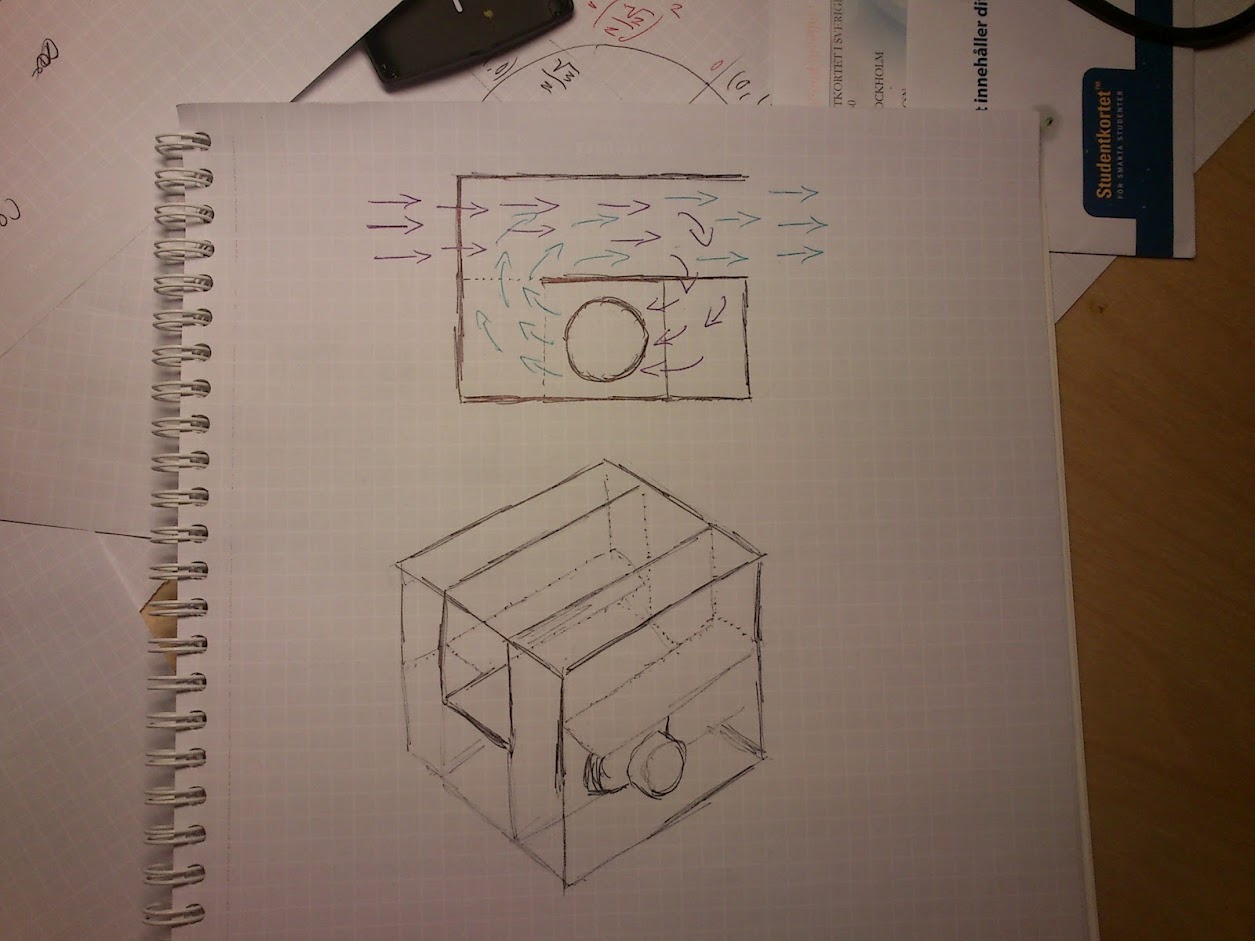
And now... feedback!
// Olle
I've been wondering some about this: Open baffled subwoofers are more efficient the larger the baffle is, so why are most baffles on the subwoofer drawings on the net so small?
Shouldn't it be possible to approximate a much larger baffle and getting more bass by folding it like in my drawing?
If you already use DSP to handle delaying the other speakers and EQing the response is there some big disadvantage of doing this?
My other idea was stacking with 4 drivers to make my subwoofer, but the shouldn't the folded one in theory have the same output but with two instead of four drivers, thus at halved cost.

And now... feedback!
// Olle
Attachments
If you have the W-style cabinet as shown in the diagram, you can extend the frequency response by bolting a box on the backside of the cabinet such that the rearwave must travel that much further before it can cancel the sound coming out of the front of the cabinet. I made a two foot deep box which adds four additional feet to the pathway of the backwave. It really helped extending the frequency response of the open baffle subwoofer.
The box you drew is effectively a bass reflex box with an very high tuning, with a big air leak on the right sideHello there all!
I've been wondering some about this: Open baffled subwoofers are more efficient the larger the baffle is, so why are most baffles on the subwoofer drawings on the net so small?
Shouldn't it be possible to approximate a much larger baffle and getting more bass by folding it like in my drawing?
The box you drew is effectively a bass reflex box with an very high tuning, with a big air leak on the right side.
Either my drawing is unclear or then all open baffle dipole woofers are also bass reflex boxes.
To clarify my drawing:
The idea is to have a normal W-frame dipole wofer a la Linkwitz but to extend the path difference and by that reduce dipole roll off.
Having a several m long subwoofer isn't practical in my case though which is why I thought I might as well fold it like in the drawing. It should still have the same response as if it was the one above shouldn't it?
What made me wonder the most was that this easy mod should according to the datasheet provided by Linkwitz more than double low frequency response. So why aren't lots of people already doing it but instead spending lots of money on more drivers?
Which made me think of my second idea:
I want a subwoofer with maximal low frequency externsion but with smallest volume possible. Building on height after folding is too impractical but what if I simply added another pair of drivers like in my second drawing?
Impulse response impact should be minimal shouldn't it since the wavelength at 80 hz is still very very much longer than the distance between the drivers.
And if I can do that I can get twice the SPL again with the same box volume
Attachments
Last edited:
Extending the path length too far will bring the lowest 1/4 wave resonance of the path down into the desired passband, which is not good. Linkwitz discusses that on his site:
Electro-acoustic models
Electro-acoustic models
Extending the path length too far will bring the lowest 1/4 wave resonance of the path down into the desired passband, which is not good. Linkwitz discusses that on his site:
Electro-acoustic models
Yes, but shouldn't it be quite easy to EQ away them with DSP?
The nulls shouldn't be that big in real life if I've understood his measurements correctly and when I tested in Edge with a 2.8 m diameter baffle the null was still at over 200 hz.
In the end I find the possible gain to be big enough to want me to test it. If the issues are too large to EQ away and it doesn't work then I will just make the standard non-folded dipole subwoofer but if it works...
Last edited:
Addition: If Edge simulates correctly then for each time I double path difference D then the frequency of the nulls are halved.
But the satelite Phoenix dipole has a D of ~ 250 mm, and it can be crossed at 1400 hz. So shouldn't it be possible to have a subwoofer with 250 * 2^4 = 4000 mm when the crossover is reduced to 1400 / 2^4 which is roughly 80 hz?
If the nulls are so horrible then why is such a large baffle at such a high frequency possible?
But the satelite Phoenix dipole has a D of ~ 250 mm, and it can be crossed at 1400 hz. So shouldn't it be possible to have a subwoofer with 250 * 2^4 = 4000 mm when the crossover is reduced to 1400 / 2^4 which is roughly 80 hz?
If the nulls are so horrible then why is such a large baffle at such a high frequency possible?
Yes, but shouldn't it be quite easy to EQ away them with DSP?
You can't EQ out a null.
In the end I find the possible gain to be big enough to want me to test it. If the issues are too large to EQ away and it doesn't work then I will just make the standard non-folded dipole subwoofer but if it works...
By all means try it. It's what we're here in DIYAudio for. I just have this nagging feeling that if it were as simple as you say, everyone would be doing it...
OllBoll,
Your long pipes will triple or even quadruple the air mass trapped in them. This is equivalent to adding mass to the cone, which in return raises Qts. Raising Qts may be a good thing up to a point, but it can result in a large resonance hump at Fs if overdone.
Apart from that the air mass at the opening of the pipe could react with SOME delay compared to the cone. This would add to the group delay, possibly making the sound really "lagging behind".
Of course you can try to extend those quarter wavelength pipes, but this lunch is not as free as you may have considered.
Rudolf
Your long pipes will triple or even quadruple the air mass trapped in them. This is equivalent to adding mass to the cone, which in return raises Qts. Raising Qts may be a good thing up to a point, but it can result in a large resonance hump at Fs if overdone.
Apart from that the air mass at the opening of the pipe could react with SOME delay compared to the cone. This would add to the group delay, possibly making the sound really "lagging behind".
Of course you can try to extend those quarter wavelength pipes, but this lunch is not as free as you may have considered.
Rudolf
OllBoll,
Your long pipes will triple or even quadruple the air mass trapped in them. This is equivalent to adding mass to the cone, which in return raises Qts. Raising Qts may be a good thing up to a point, but it can result in a large resonance hump at Fs if overdone.
Apart from that the air mass at the opening of the pipe could react with SOME delay compared to the cone. This would add to the group delay, possibly making the sound really "lagging behind".
Of course you can try to extend those quarter wavelength pipes, but this lunch is not as free as you may have considered.
Rudolf
Of couse I'd have to delay the other speakers to compensate the longer path, but that and the resonance bump should also be easy to fix with some DSP.
You can't EQ out a null.
By all means try it. It's what we're here in DIYAudio for. I just have this nagging feeling that if it were as simple as you say, everyone would be doing it...
If I reduce the surrounding frequencies I can remove nulls. Even if I EQ away say 24 or even 36 db it isn't really an issue since the noise generated from the resolution loss will be lowpassed away. And in Linkwitz own dipole woofer the null isn't that big: http://www.linkwitzlab.com/images/graphics/w2a.gif
EDIT: When I say 24 or 36, I mean inclusive to a 24 to 36 db headroom for volume management. So in the end it's - 48 to -72 db or somewhere there but the same argument stands, the noise generated will be lowpassed away.
And if someone wonders: Currently I plan to be using a MiniDSP to take care of all the DSP needed for this project, it just seems too convenient not to use
Last edited:
To avoid the group delay, increase the path of the rear wave, but not the front wave. I am not sure what the front wave is doing in your box - I see no point delaying the front wave as well.
My idea of adding a two foot deep box (open on both ends) to the back of the W-style open baffle would add four feet to the path length without delaying the front wave. Also, there is an expansion once the wave leaves the box which means not much backpressure is added to the backside of the drivers. Your open baffle subwoofer box is probably at least 3 feet from the back wall, so bolting on the box should not create a problem with the back wall (if it does, make it only 1 1/2 feed deep.
My idea of adding a two foot deep box (open on both ends) to the back of the W-style open baffle would add four feet to the path length without delaying the front wave. Also, there is an expansion once the wave leaves the box which means not much backpressure is added to the backside of the drivers. Your open baffle subwoofer box is probably at least 3 feet from the back wall, so bolting on the box should not create a problem with the back wall (if it does, make it only 1 1/2 feed deep.
To avoid the group delay, increase the path of the rear wave, but not the front wave. I am not sure what the front wave is doing in your box - I see no point delaying the front wave as well.
My idea of adding a two foot deep box (open on both ends) to the back of the W-style open baffle would add four feet to the path length without delaying the front wave. Also, there is an expansion once the wave leaves the box which means not much backpressure is added to the backside of the drivers. Your open baffle subwoofer box is probably at least 3 feet from the back wall, so bolting on the box should not create a problem with the back wall (if it does, make it only 1 1/2 feed deep.
But while the front would be exempt from the group delay and have a smooth response the rear output wouldn't so correcting with EQ would be impossible. DIY-dipole-1
My ideal is to create a speaker that is as omnidirectional as possible, so symmetrical front and rear radiation is one of my goals. I'm not planning for a listening spot but rather want to spread the music in all of the room, which is why I do not want a fixed front/rear direction on the speaker or subwoofer.
You can bolt a box (open on both sides) on the front as well if you are worried about inconsistent loading and its impact on the relative wave forms (although it may look silly) ...
Again, the size of the added on box is fairly large since it can be as large as the entire W-shaped open baffle, so there is little directionality to the back wave, but it does lower the frequency response. If you have the W-style box, I suggest trying it and listening to how it sounds instead of being totally controlled by the theory of how these things work.
Again, the size of the added on box is fairly large since it can be as large as the entire W-shaped open baffle, so there is little directionality to the back wave, but it does lower the frequency response. If you have the W-style box, I suggest trying it and listening to how it sounds instead of being totally controlled by the theory of how these things work.
- Status
- This old topic is closed. If you want to reopen this topic, contact a moderator using the "Report Post" button.
- Home
- Loudspeakers
- Subwoofers
- Folded Dipole Subwoofer
